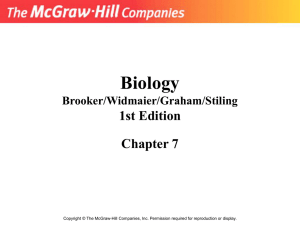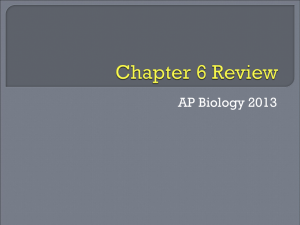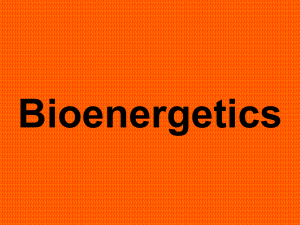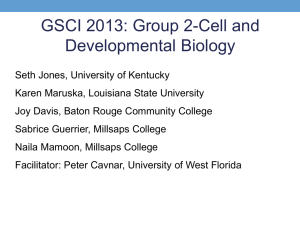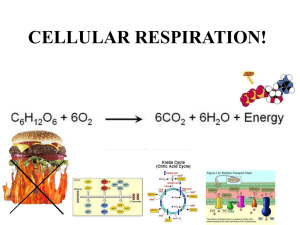METABOLISM:
advertisement
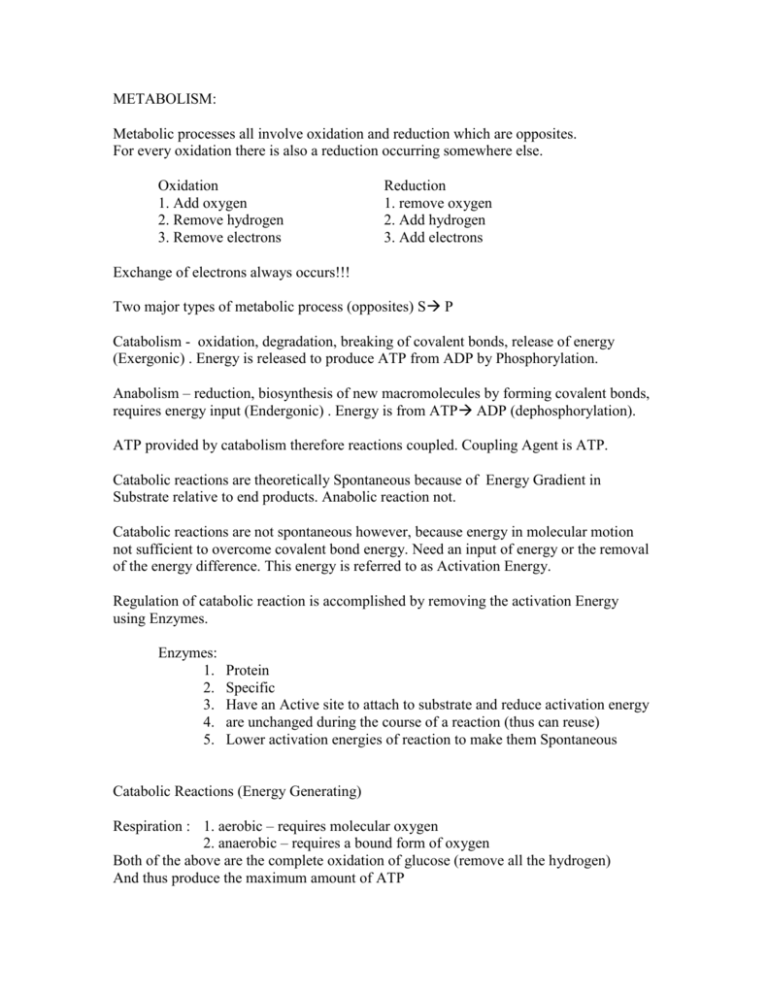
METABOLISM:
Metabolic processes all involve oxidation and reduction which are opposites.
For every oxidation there is also a reduction occurring somewhere else.
Oxidation
1. Add oxygen
2. Remove hydrogen
3. Remove electrons
Reduction
1. remove oxygen
2. Add hydrogen
3. Add electrons
Exchange of electrons always occurs!!!
Two major types of metabolic process (opposites) S P
Catabolism - oxidation, degradation, breaking of covalent bonds, release of energy
(Exergonic) . Energy is released to produce ATP from ADP by Phosphorylation.
Anabolism – reduction, biosynthesis of new macromolecules by forming covalent bonds,
requires energy input (Endergonic) . Energy is from ATP ADP (dephosphorylation).
ATP provided by catabolism therefore reactions coupled. Coupling Agent is ATP.
Catabolic reactions are theoretically Spontaneous because of Energy Gradient in
Substrate relative to end products. Anabolic reaction not.
Catabolic reactions are not spontaneous however, because energy in molecular motion
not sufficient to overcome covalent bond energy. Need an input of energy or the removal
of the energy difference. This energy is referred to as Activation Energy.
Regulation of catabolic reaction is accomplished by removing the activation Energy
using Enzymes.
Enzymes:
1.
2.
3.
4.
5.
Protein
Specific
Have an Active site to attach to substrate and reduce activation energy
are unchanged during the course of a reaction (thus can reuse)
Lower activation energies of reaction to make them Spontaneous
Catabolic Reactions (Energy Generating)
Respiration : 1. aerobic – requires molecular oxygen
2. anaerobic – requires a bound form of oxygen
Both of the above are the complete oxidation of glucose (remove all the hydrogen)
And thus produce the maximum amount of ATP
Fermentation: occurs in the presence or absence of oxygen because not required.
Incomplete oxidation of glucose ( not all hydrogen removed) and therefore very
little ATP produced.
Three biochemical processes are potentially involved with Respiration and fermentation
1. Glycolysis (removal of hydrogen with a coenzyme NADNADH)
2. Tricarboxylic Acid cycle {TCA, Citric Acid or Kreb’s cycles} (removal of hydroden
with NADNADH and FAD—FADH)
3. Oxidative phosphorylation (using cytochromes to transfer hydrogen from NADH and
FADH to a form of oxygen (molecular or bound).
Glycolysis:
Glucose pyruvic acid + ATP + NADH
Three major steps:
1. Glucose Fructose Diphosphate Activation using ATP
2. Fructose Diphosphate Glyceraldehyde Phosphate splitting glucose with
Aldolase
3. Glyceraldehyde Phosphate pyruvic acid + ATP + NADH oxidation by
removal of hydrogen – no oxygen required , and phosphorylation. No carbon
dioxide given off.
TCA cycle:
Pyruvic Acid Carbon Dioxide + ATP + FADH + NADH
Oxidation by removal of hydrogen – no oxygen required, and phosphorylation.
By definition decarboxylation occurs. Carbon dioxide is given off in the TCA cycle
There is actually a transition step between Glycolysis and The TCA cycle proper.
Pyruvic Acid Acetic acid + Carbon dioxide + NADH
Oxidative Phosphorylation:
Oxidation of coenzymes and phosphorylation occurs.
NADH + FADH + Oxygen (molecular or bound) NAD + FAD + reduced Oxygen
+ATP
Hydrogen transferred from NADH and FADH to cytochromes
Cytochromes transfer hydrogen to a form of oxygen to reduce it.
Electrons flow through the cytochromes in a membrane in this process and Protons back
and forth across the membrane using ATPase which also produces ATP
For each NADH NAD
FADHFAD
3 ATP’s produced
2 ATP’s produced
All three processes described above occur in respiration
Only glycolysis in Fermentation
Fermentation is
Glucose acid/alcohol + ATP
It is therefore Gylcolysis plus one additional step to convert NADHNAD
That step is:Pyruvic Acid +NADH acid/alcohol +NAD
The hydrogen is transferred from the NADH to the pyruvic acid to produce the
acid/alcohol
Glycolysis and the TCA cycle occur in the cytoplasm of Prokaryotes. Oxidative
Phosphorylation in the Cell membrane
Glycolysis occurs in the cytoplasm of Eukaryotes. The TCA cycle and Oxidative
phosphorylation in the mitochondria.
PHOTOSYNTHESIS: is the reduction of carbon dioxide to glucose using solar
radiation.
6CO2
+ 6H2O C6H12O6 + 6O2
There are two major types of reaction involved in the above process
1. Light Dependant
2. Light Independent
In the light dependant reactions chlorophyll absorbs light as a source of energy. There are
two types of chlorophyll molecules and associated reactions termed photosystems I and
II.
Photosystem II occurs first.
On the absorption of a photon of light energy the chlorophyll becomes oxidized by the
loss of an electron. The electron passes through a cytochrome chain while protons move
back and forth across the membrane in which the cytochromes are located resulting in the
production of ATP. The electrons lost from chlorophyll on oxidation and the protons
moving across the membrane are derived from water when it is photolysed as follows:H20 O + 2H
2H 2H+ + 2eIn Photosystem I absorption of light also causes oxidation of chlorophyll by loss of an
electron which the enters a second cytochrome chain. The electron flows through the
chain just as in PSII however protons do not pass across the membrane and therefore
ATP is not produced. The electron lost from chlorophyll is replaced by electrons from the
cytochrome chain of PS II.
When electrons come out of the cytochrome chain associated with PSI they recombine
with protons from water and attach to NADP (a coenzyme) reducing it to NADPH.
In summary:
PSII generates ATP energy
PSI generates reducing power (H from water) in the form of NADPH
Light Independent Reactions: require
1. Carbon Dioxide from air
2. ATP from PS II
3. H in the form of NADPH from PSI
4. An enzyme Ribulose Biphosphate carboxylase (Rubisco)
5. Sugar – Ribulose biphosphate to attach Carbon dioxide to.
There are three major reactions:
1 Ribulose Biphosphate + carbon dioxide Phosphoglyceraldehyde {PGA}
(catalyzed by Rubisco)
2. Some PGA is converted to Glucose by the reverse of glycolysis. This requires
ATP and H from NADPH (reduction) both generated in the Light dependant
reactions.
3. . Some PGA is used to regenerate Ribulose biphosphate. This also requires
ATP and H from NADPH (reduction) both generated in the Light dependant
Reactions. This particular series of reactions is referred to as the Calvin
Benson cycle.
Light dependant reactions occur in the thylakoid membranes and the light independent
reactions in the stroma of the chloroplasts.


